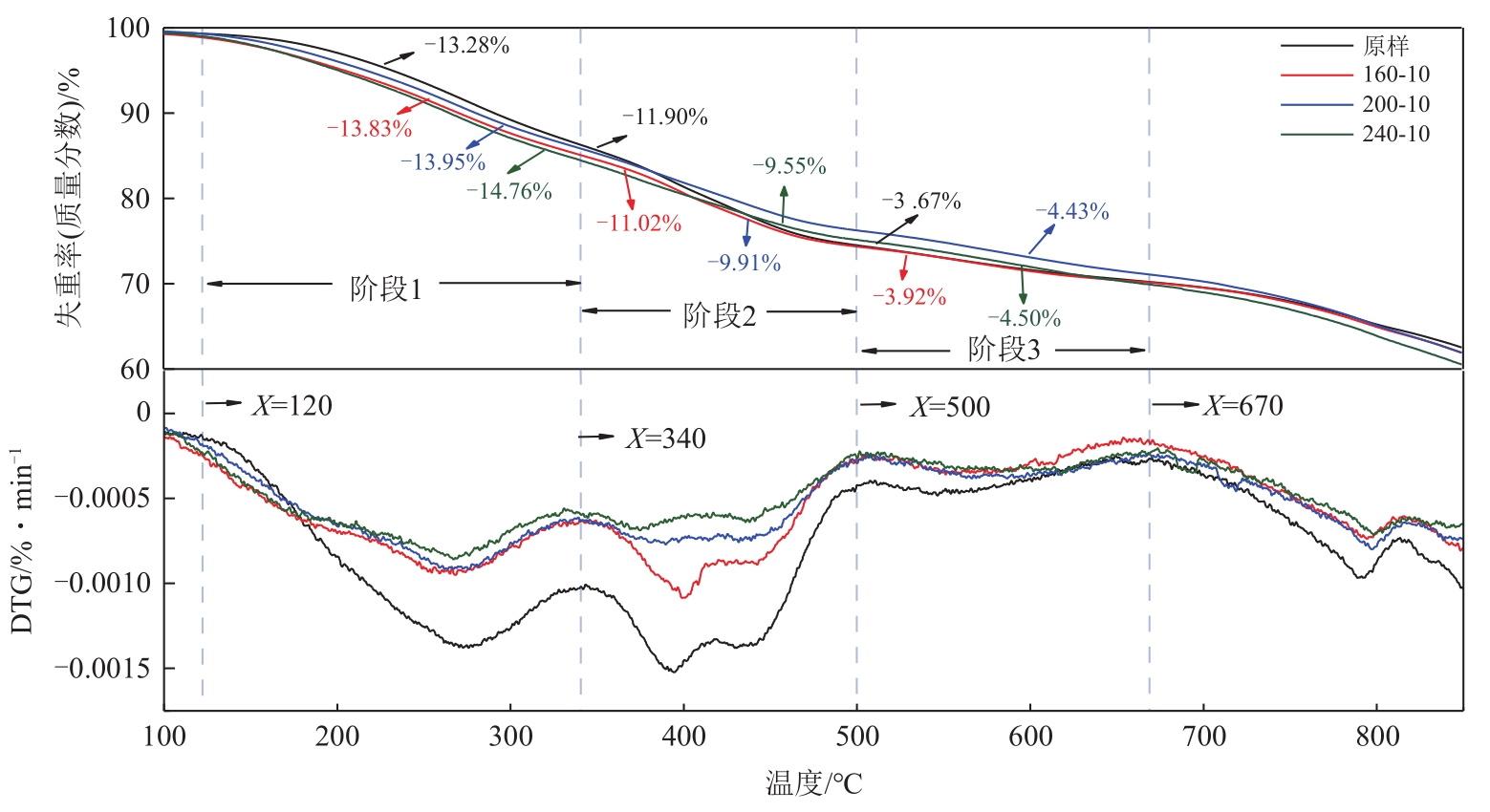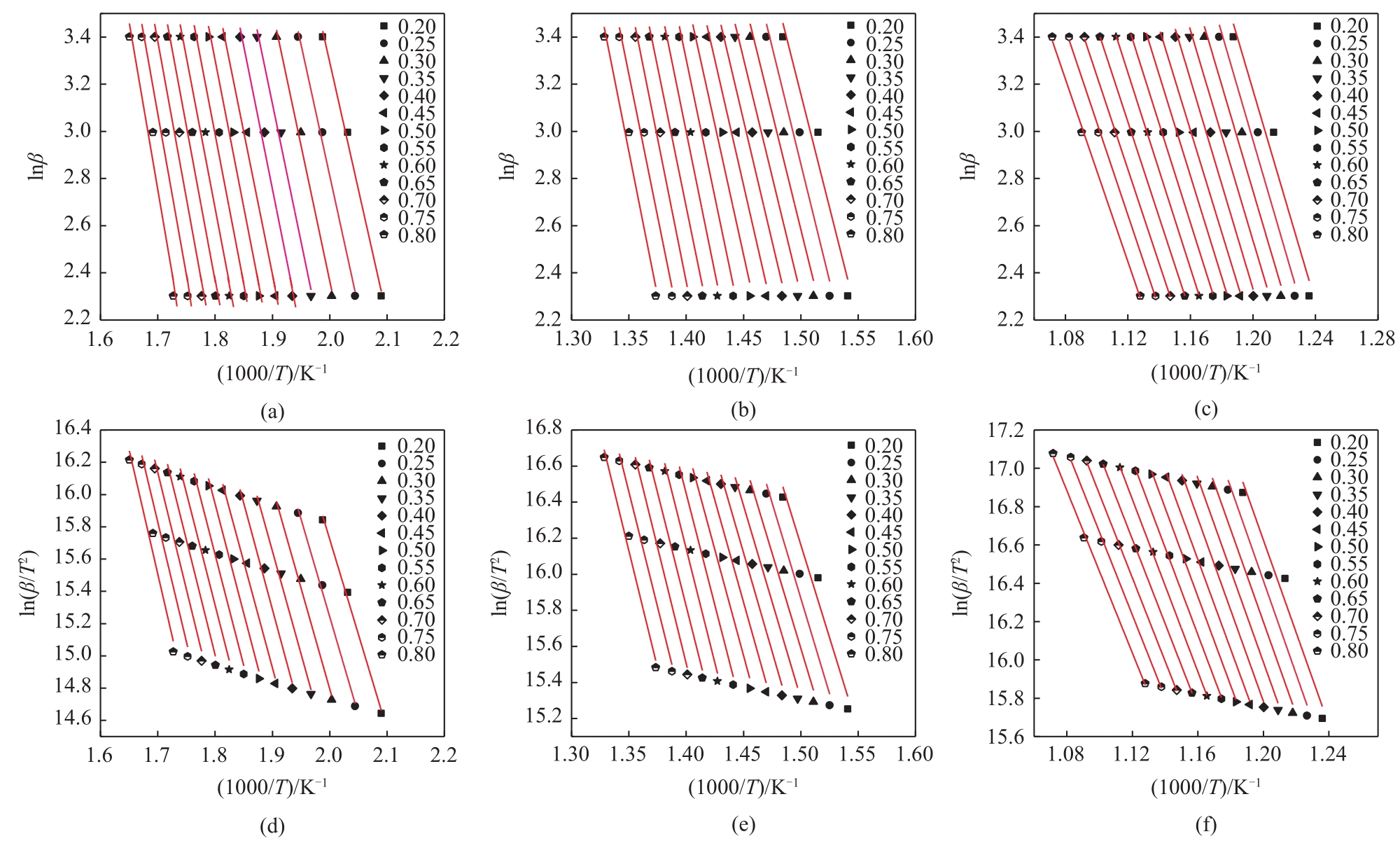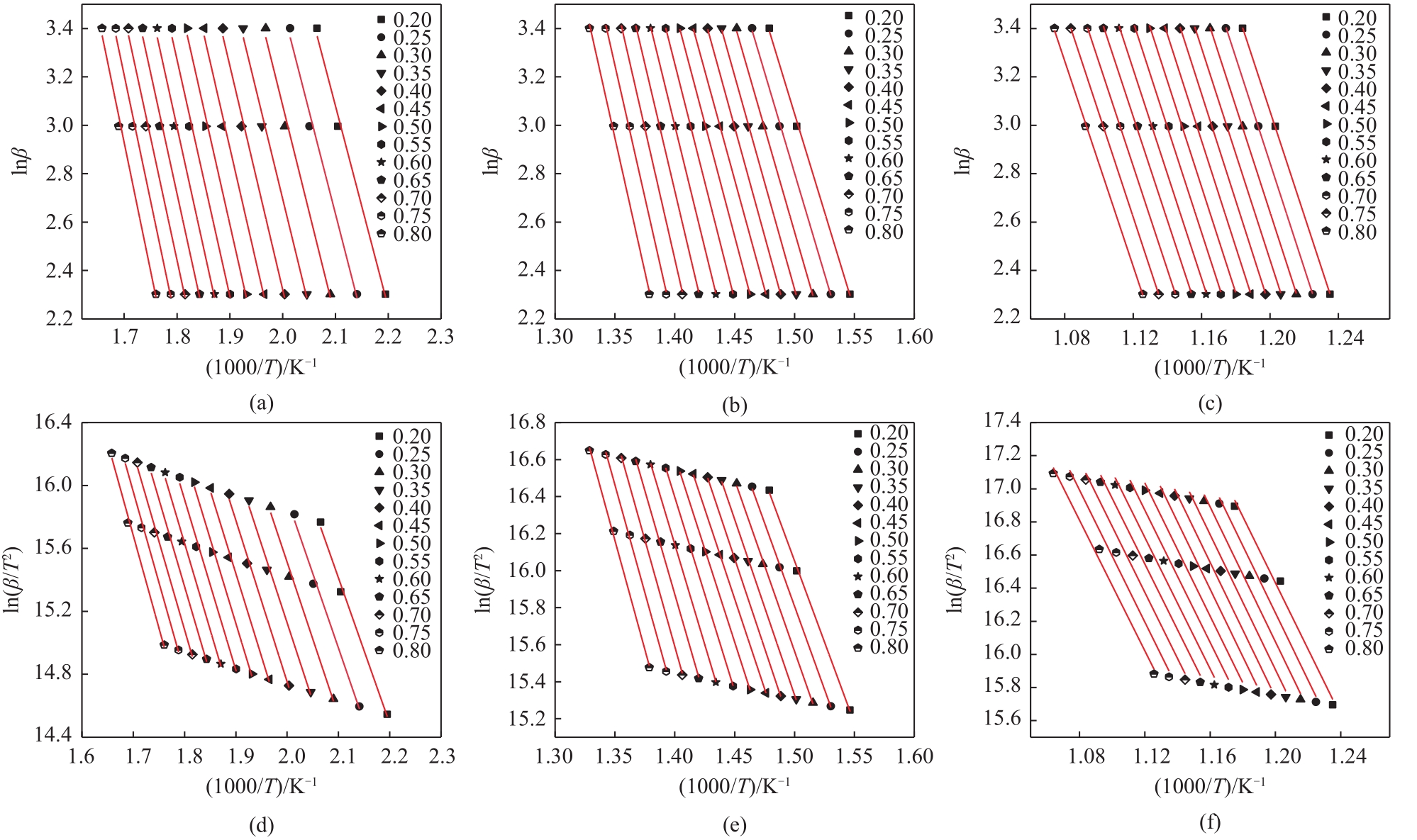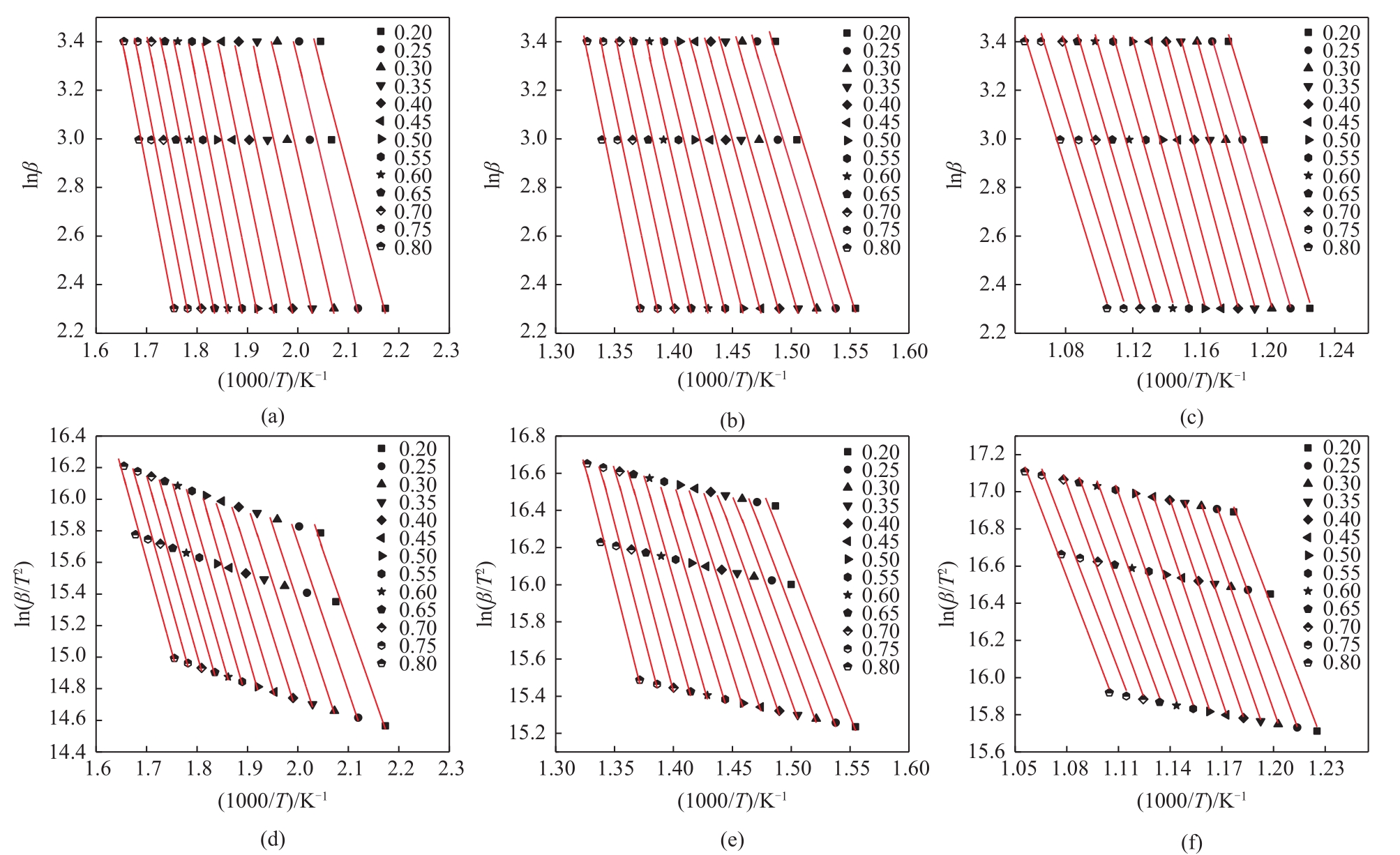Chemical Industry and Engineering Progress ›› 2023, Vol. 42 ›› Issue (2): 603-613.DOI: 10.16085/j.issn.1000-6613.2022-1208
Previous Articles Next Articles
Effect of hydrothermal treatment on pyrolysis characteristics and kinetics of oily sludge
DUAN Yihang( ), GAO Ningbo(
), GAO Ningbo( ), QUAN Cui
), QUAN Cui
- CNPC Safety and Environmental Protection Technology Research Institute Co. , Ltd. , Xi’an Key Laboratory of Solid Waste Recycling and Resource Recovery, School of Energy and Power Engineering, Xi’an Jiaotong University, Xi’an 710049, Shaanxi, China
-
Received:2022-06-28Revised:2022-08-18Online:2023-03-13Published:2023-02-25 -
Contact:GAO Ningbo
水热处理对含油污泥热解特性及动力学影响
- 西安交通大学能源与动力工程学院,西安市固体废物资源再生与循环利用重点实验室,中国石油集团安全环保技术研究院有限公司,陕西 西安 710049
-
通讯作者:高宁博 -
作者简介:段一航(1994—),男,博士研究生,研究方向为含油污泥资源化利用。E-mail:yihangduan@foxmail.com。 -
基金资助:陕西省重点研发计划(2021GY-114);石油石化污染物控制与处理国家重点实验室开放课题(PPC 2020002)
CLC Number:
Cite this article
DUAN Yihang, GAO Ningbo, QUAN Cui. Effect of hydrothermal treatment on pyrolysis characteristics and kinetics of oily sludge[J]. Chemical Industry and Engineering Progress, 2023, 42(2): 603-613.
段一航, 高宁博, 全翠. 水热处理对含油污泥热解特性及动力学影响[J]. 化工进展, 2023, 42(2): 603-613.
share this article
Add to citation manager EndNote|Ris|BibTeX
URL: https://hgjz.cip.com.cn/EN/10.16085/j.issn.1000-6613.2022-1208
| 样品 | 工业分析/% | 元素分析/% | 热值/MJ·kg-1 | 含油率/% | |||||||
|---|---|---|---|---|---|---|---|---|---|---|---|
| 水分 | 挥发分 | 灰分 | 固定碳 | C | H | O | N | S | |||
| OS | 54.4 | 26.35 | 19.04 | 0.21 | 22.80 | 3.17 | 29.88 | 0.43 | 1.89 | 8.48 | 23.87 |
| 样品 | 工业分析/% | 元素分析/% | 热值/MJ·kg-1 | 含油率/% | |||||||
|---|---|---|---|---|---|---|---|---|---|---|---|
| 水分 | 挥发分 | 灰分 | 固定碳 | C | H | O | N | S | |||
| OS | 54.4 | 26.35 | 19.04 | 0.21 | 22.80 | 3.17 | 29.88 | 0.43 | 1.89 | 8.48 | 23.87 |
| 样品 | β①/K·min-1 | 第一阶段 | 第二阶段 | 第三阶段 | ||||||
|---|---|---|---|---|---|---|---|---|---|---|
| Ti1②/K | Tp1③/K | -Rp1④/%·min-1 | Ti2/K | Tp2/K | -Rp2/%·min-1 | Ti3/K | Tp3/K | -Rp3/%·min-1 | ||
| 原样 | 10 | 106.11 | 343.11 | 13.28 | 343.11 | 510.11 | 11.90 | 510.11 | 650.09 | 3.67 |
| 160-10 | 10 | 110.15 | 338.06 | 13.83 | 338.06 | 505.01 | 11.02 | 505.01 | 658.16 | 3.92 |
| 200-10 | 10 | 107.88 | 338.03 | 13.95 | 338.03 | 506.04 | 9.91 | 395.26 | 655.90 | 4.34 |
| 240-10 | 10 | 110.04 | 335.14 | 14.76 | 335.14 | 505.04 | 9.55 | 505.04 | 650.19 | 4.50 |
| 样品 | β①/K·min-1 | 第一阶段 | 第二阶段 | 第三阶段 | ||||||
|---|---|---|---|---|---|---|---|---|---|---|
| Ti1②/K | Tp1③/K | -Rp1④/%·min-1 | Ti2/K | Tp2/K | -Rp2/%·min-1 | Ti3/K | Tp3/K | -Rp3/%·min-1 | ||
| 原样 | 10 | 106.11 | 343.11 | 13.28 | 343.11 | 510.11 | 11.90 | 510.11 | 650.09 | 3.67 |
| 160-10 | 10 | 110.15 | 338.06 | 13.83 | 338.06 | 505.01 | 11.02 | 505.01 | 658.16 | 3.92 |
| 200-10 | 10 | 107.88 | 338.03 | 13.95 | 338.03 | 506.04 | 9.91 | 395.26 | 655.90 | 4.34 |
| 240-10 | 10 | 110.04 | 335.14 | 14.76 | 335.14 | 505.04 | 9.55 | 505.04 | 650.19 | 4.50 |
| 转化率(α) | 第一阶段 | 第二阶段 | 第三阶段 | |||
|---|---|---|---|---|---|---|
| E(FWO)/kJ·mol-1 | E(KAS)/kJ·mol-1 | E(FWO)/kJ·mol-1 | E(KAS)/kJ·mol-1 | E(FWO)/kJ·mol--1 | E(KAS)/kJ·mol-1 | |
| 0.20 | 85.35 | 97.94 | 151.89 | 145.66 | 177.58 | 200.61 |
| 0.25 | 87.80 | 100.68 | 156.48 | 149.32 | 179.48 | 202.69 |
| 0.30 | 90.65 | 103.84 | 155.76 | 153.72 | 177.34 | 200.45 |
| 0.35 | 92.61 | 106.08 | 158.29 | 157.63 | 176.08 | 199.28 |
| 0.40 | 95.71 | 109.49 | 162.56 | 160.79 | 175.13 | 198.37 |
| 0.45 | 95.31 | 109.16 | 167.86 | 161.54 | 170.94 | 194.13 |
| 0.50 | 98.63 | 112.90 | 174.18 | 167.03 | 169.44 | 192.63 |
| 0.55 | 100.13 | 114.48 | 184.45 | 173.93 | 165.88 | 189.06 |
| 0.60 | 100.92 | 115.48 | 188.80 | 179.75 | 163.91 | 186.98 |
| 0.65 | 103.37 | 118.47 | 187.62 | 186.06 | 159.87 | 182.82 |
| 0.70 | 105.51 | 120.55 | 192.20 | 191.55 | 157.66 | 180.66 |
| 0.75 | 108.11 | 123.46 | 190.07 | 193.46 | 156.01 | 179.08 |
| 0.80 | 112.38 | 128.12 | 193.62 | 195.96 | 153.08 | 176.17 |
| 均值 | 98.19 | 112.36 | 174.14 | 170.49 | 167.88 | 190.99 |
| 转化率(α) | 第一阶段 | 第二阶段 | 第三阶段 | |||
|---|---|---|---|---|---|---|
| E(FWO)/kJ·mol-1 | E(KAS)/kJ·mol-1 | E(FWO)/kJ·mol-1 | E(KAS)/kJ·mol-1 | E(FWO)/kJ·mol--1 | E(KAS)/kJ·mol-1 | |
| 0.20 | 85.35 | 97.94 | 151.89 | 145.66 | 177.58 | 200.61 |
| 0.25 | 87.80 | 100.68 | 156.48 | 149.32 | 179.48 | 202.69 |
| 0.30 | 90.65 | 103.84 | 155.76 | 153.72 | 177.34 | 200.45 |
| 0.35 | 92.61 | 106.08 | 158.29 | 157.63 | 176.08 | 199.28 |
| 0.40 | 95.71 | 109.49 | 162.56 | 160.79 | 175.13 | 198.37 |
| 0.45 | 95.31 | 109.16 | 167.86 | 161.54 | 170.94 | 194.13 |
| 0.50 | 98.63 | 112.90 | 174.18 | 167.03 | 169.44 | 192.63 |
| 0.55 | 100.13 | 114.48 | 184.45 | 173.93 | 165.88 | 189.06 |
| 0.60 | 100.92 | 115.48 | 188.80 | 179.75 | 163.91 | 186.98 |
| 0.65 | 103.37 | 118.47 | 187.62 | 186.06 | 159.87 | 182.82 |
| 0.70 | 105.51 | 120.55 | 192.20 | 191.55 | 157.66 | 180.66 |
| 0.75 | 108.11 | 123.46 | 190.07 | 193.46 | 156.01 | 179.08 |
| 0.80 | 112.38 | 128.12 | 193.62 | 195.96 | 153.08 | 176.17 |
| 均值 | 98.19 | 112.36 | 174.14 | 170.49 | 167.88 | 190.99 |
| 转化率(α) | 第一阶段 | 第二阶段 | 第三阶段 | |||
|---|---|---|---|---|---|---|
| R2(FWO) | R2(KAS) | R2(FWO) | R2(KAS) | R2(FWO) | R2(KAS) | |
| 0.20 | 0.9957 | 0.9954 | 0.9601 | 0.9989 | 0.9653 | 0.9895 |
| 0.25 | 0.9959 | 0.9939 | 0.9671 | 0.9994 | 0.9738 | 0.9898 |
| 0.30 | 0.9936 | 0.9943 | 0.9657 | 0.9992 | 0.981 | 0.9891 |
| 0.35 | 0.9924 | 0.9939 | 0.9676 | 0.9998 | 0.9861 | 0.9878 |
| 0.40 | 0.9872 | 0.9953 | 0.9733 | 0.9999 | 0.9913 | 0.9871 |
| 0.45 | 0.9884 | 0.9959 | 0.9764 | 0.9999 | 0.9967 | 0.9858 |
| 0.50 | 0.9799 | 0.9964 | 0.971 | 0.9999 | 0.9982 | 0.9836 |
| 0.55 | 0.9759 | 0.9942 | 0.9811 | 0.9999 | 0.9989 | 0.9829 |
| 0.60 | 0.9715 | 0.994 | 0.9809 | 0.9998 | 0.9998 | 0.9841 |
| 0.65 | 0.9703 | 0.9949 | 0.9826 | 0.9992 | 0.9999 | 0.9856 |
| 0.70 | 0.9683 | 0.9963 | 0.9849 | 0.999 | 0.9996 | 0.9886 |
| 0.75 | 0.9683 | 0.9956 | 0.986 | 0.999 | 0.9987 | 0.9894 |
| 0.80 | 0.9631 | 0.9959 | 0.9844 | 0.9983 | 0.9985 | 0.9918 |
| 均值 | 0.9808 | 0.9951 | 0.9755 | 0.9994 | 0.99135 | 0.9875 |
| 转化率(α) | 第一阶段 | 第二阶段 | 第三阶段 | |||
|---|---|---|---|---|---|---|
| R2(FWO) | R2(KAS) | R2(FWO) | R2(KAS) | R2(FWO) | R2(KAS) | |
| 0.20 | 0.9957 | 0.9954 | 0.9601 | 0.9989 | 0.9653 | 0.9895 |
| 0.25 | 0.9959 | 0.9939 | 0.9671 | 0.9994 | 0.9738 | 0.9898 |
| 0.30 | 0.9936 | 0.9943 | 0.9657 | 0.9992 | 0.981 | 0.9891 |
| 0.35 | 0.9924 | 0.9939 | 0.9676 | 0.9998 | 0.9861 | 0.9878 |
| 0.40 | 0.9872 | 0.9953 | 0.9733 | 0.9999 | 0.9913 | 0.9871 |
| 0.45 | 0.9884 | 0.9959 | 0.9764 | 0.9999 | 0.9967 | 0.9858 |
| 0.50 | 0.9799 | 0.9964 | 0.971 | 0.9999 | 0.9982 | 0.9836 |
| 0.55 | 0.9759 | 0.9942 | 0.9811 | 0.9999 | 0.9989 | 0.9829 |
| 0.60 | 0.9715 | 0.994 | 0.9809 | 0.9998 | 0.9998 | 0.9841 |
| 0.65 | 0.9703 | 0.9949 | 0.9826 | 0.9992 | 0.9999 | 0.9856 |
| 0.70 | 0.9683 | 0.9963 | 0.9849 | 0.999 | 0.9996 | 0.9886 |
| 0.75 | 0.9683 | 0.9956 | 0.986 | 0.999 | 0.9987 | 0.9894 |
| 0.80 | 0.9631 | 0.9959 | 0.9844 | 0.9983 | 0.9985 | 0.9918 |
| 均值 | 0.9808 | 0.9951 | 0.9755 | 0.9994 | 0.99135 | 0.9875 |
| 转化率(α) | 第一阶段 | 第二阶段 | 第三阶段 | |||
|---|---|---|---|---|---|---|
| E(FWO)/kJ·mol-1 | E(KAS)/kJ·mol-1 | E(FWO)/kJ·mol-1 | E(KAS)/kJ·mol-1 | E(FWO)/kJ·mol-1 | E(KAS)/kJ·mol-1 | |
| 0.20 | 65.75 | 76.99 | 128.03 | 145.66 | 170.07 | 166.53 |
| 0.25 | 67.17 | 78.65 | 131.43 | 149.32 | 171.73 | 168.69 |
| 0.30 | 69.39 | 81.23 | 135.46 | 153.72 | 172.29 | 169.27 |
| 0.35 | 70.65 | 82.72 | 139.09 | 157.63 | 172.68 | 169.44 |
| 0.40 | 73.02 | 85.38 | 142.02 | 160.79 | 174.26 | 169.27 |
| 0.45 | 75.07 | 87.71 | 142.65 | 161.54 | 173.55 | 169.19 |
| 0.50 | 76.42 | 89.29 | 147.79 | 167.03 | 172.92 | 167.11 |
| 0.55 | 77.13 | 90.21 | 154.19 | 173.93 | 172.13 | 165.86 |
| 0.60 | 78.32 | 91.54 | 159.64 | 179.75 | 170.94 | 164.95 |
| 0.65 | 78.87 | 92.28 | 165.57 | 186.06 | 169.36 | 164.70 |
| 0.70 | 79.90 | 93.53 | 170.70 | 191.55 | 169.04 | 165.61 |
| 0.75 | 82.11 | 95.94 | 172.36 | 193.46 | 169.12 | 165.61 |
| 0.80 | 83.77 | 97.85 | 174.66 | 195.96 | 167.38 | 163.78 |
| 均值 | 75.20 | 87.95 | 151.04 | 170.49 | 171.19 | 166.92 |
| 转化率(α) | 第一阶段 | 第二阶段 | 第三阶段 | |||
|---|---|---|---|---|---|---|
| E(FWO)/kJ·mol-1 | E(KAS)/kJ·mol-1 | E(FWO)/kJ·mol-1 | E(KAS)/kJ·mol-1 | E(FWO)/kJ·mol-1 | E(KAS)/kJ·mol-1 | |
| 0.20 | 65.75 | 76.99 | 128.03 | 145.66 | 170.07 | 166.53 |
| 0.25 | 67.17 | 78.65 | 131.43 | 149.32 | 171.73 | 168.69 |
| 0.30 | 69.39 | 81.23 | 135.46 | 153.72 | 172.29 | 169.27 |
| 0.35 | 70.65 | 82.72 | 139.09 | 157.63 | 172.68 | 169.44 |
| 0.40 | 73.02 | 85.38 | 142.02 | 160.79 | 174.26 | 169.27 |
| 0.45 | 75.07 | 87.71 | 142.65 | 161.54 | 173.55 | 169.19 |
| 0.50 | 76.42 | 89.29 | 147.79 | 167.03 | 172.92 | 167.11 |
| 0.55 | 77.13 | 90.21 | 154.19 | 173.93 | 172.13 | 165.86 |
| 0.60 | 78.32 | 91.54 | 159.64 | 179.75 | 170.94 | 164.95 |
| 0.65 | 78.87 | 92.28 | 165.57 | 186.06 | 169.36 | 164.70 |
| 0.70 | 79.90 | 93.53 | 170.70 | 191.55 | 169.04 | 165.61 |
| 0.75 | 82.11 | 95.94 | 172.36 | 193.46 | 169.12 | 165.61 |
| 0.80 | 83.77 | 97.85 | 174.66 | 195.96 | 167.38 | 163.78 |
| 均值 | 75.20 | 87.95 | 151.04 | 170.49 | 171.19 | 166.92 |
| 1 | DUAN Yihang, GAO Ningbo, SIPRA Ayesha Tariq, et al. Characterization of heavy metals and oil components in the products of oily sludge after hydrothermal treatment[J]. Journal of Hazardous Materials, 2022, 424: 127293. |
| 2 | ZHOU Lingsheng, JIANG Xiumin, LIU Jianguo. Characteristics of oily sludge combustion in circulating fluidized beds[J]. Journal of Hazardous Materials, 2009, 170(1): 175-179. |
| 3 | SILVA L J DA, ALVES F C, DE FRANÇA F P. A review of the technological solutions for the treatment of oily sludges from petroleum refineries[J]. Waste Management & Research, 2012, 30(10): 1016-1030. |
| 4 | TANG Siqi, ZHENG Chunmiao, YAN Feng, et al. Product characteristics and kinetics of sewage sludge pyrolysis driven by alkaline earth metals[J]. Energy, 2018, 153: 921-932. |
| 5 | ZUBAIDY E A H, ABOUELNASR D M. Fuel recovery from waste oily sludge using solvent extraction[J]. Process Safety and Environmental Protection, 2010, 88(5): 318-326. |
| 6 | PUASA S W, ISMAIL K N, MUSMAN M Z A, et al. Enhanced oily sludge dewatering using plant-based surfactant technology[J]. Materials Today: Proceedings, 2019, 19: 1159-1165. |
| 7 | MANARA P, ZABANIOTOU A. Towards sewage sludge based biofuels via thermochemical conversion—A review[J]. Renewable and Sustainable Energy Reviews, 2012, 16(5): 2566-2582. |
| 8 | GAO Ningbo, DUAN Yihang, LI Zongyang, et al. Hydrothermal treatment combined with in situ mechanical compression for floated oily sludge dewatering[J]. Journal of Hazardous Materials, 2021, 402: 124173. |
| 9 | XU Menghan, ZHANG Jie, LIU Haifeng, et al. The resource utilization of oily sludge by co-gasification with c oal[J]. Fuel, 2014, 126: 55-61. |
| 10 | 董向元, 郭淑青, 杨继涛, 等. 玉米秸秆水热焦热解及动力学特性研究[J]. 林产化学与工业, 2018, 38(3): 83-89. |
| DONG Xiangyuan, GUO Shuqing, YANG Jitao, et al. Pyrolysis and kinetic characteristics of corn stalk char from hydrothermal carbonization[J]. Chemistry and Industry of Forest Products, 2018, 38(3): 83-89. | |
| 11 | 邢献军, 杨静, 范方宇, 等. 木屑及其水热炭的热解特性和动力学对比[J]. 农业工程学报, 2017, 33(4): 258-264. |
| XING Xianjun, YANG Jing, FAN Fangyu, et al. Comparison of pyrolysis characteristics and kinetics of sawdust and its hydrochar[J]. Transactions of the Chinese Society of Agricultural Engineering, 2017, 33(4): 258-264. | |
| 12 | WANG Shule, WEN Yuming, SHI Ziyi, et al. Effect of hydrothermal carbonization pretreatment on the pyrolysis behavior of the digestate of agricultural waste: A view on kinetics and thermodynamics[J]. Chemical Engineering Journal, 2022, 431: 133881. |
| 13 | ZHANG Jingmiao, XIA Ao, ZHU Xianqing, et al. Co-production of carbon quantum dots and biofuels via hydrothermal conversion of biomass[J]. Fuel Processing Technology, 2022, 232: 107276. |
| 14 | 高昌胜, 魏茂, 蒋文广, 等. 基于含油污泥热解残渣的路基材料制备与性能评价[J]. 硅酸盐通报, 2019, 38(6): 1895-1900. |
| GAO Changsheng, WEI Mao, JIANG Wenguang, et al. Preparation and performance evaluation of roadbed materials based on pyrolysis residue of oily sludge[J]. Bulletin of the Chinese Ceramic Society, 2019, 38(6): 1895-1900. | |
| 15 | 张秀霞, 贾宏宇, 刘炳琨. 超声处理对污泥热解特性及反应动力学影响[J]. 中国石油大学学报(自然科学版), 2022, 46(1): 171-176. |
| ZHANG Xiuxia, JIA Hongyu, LIU Bingkun. Effects of ultrasonic treatment on pyrolysis characteristics and reaction kinetics of municipal sludge[J]. Journal of China University of Petroleum (Edition of Natural Science), 2022, 46(1): 171-176. | |
| 16 | 刘承飞, 李江平, 刘大方, 等. 废旧电脑印刷电路板的热解特性及动力学分析[J]. 有色金属科学与工程, 2022, 13(1): 38-43. |
| LIU Chengfei, LI Jiangping, LIU Dafang, et al. Pyrolysis characteristics and kinetics analysis of waste computer printed circuit board[J]. Nonferrous Metals Science and Engineering, 2022, 13(1): 38-43. | |
| 17 | MIAN Inamullah, LI Xian, JIAN Yiming, et al. Kinetic study of biomass pellet pyrolysis by using distributed activation energy model and Coats Redfern methods and their comparison[J]. Bioresource Technology, 2019, 294: 122099. |
| 18 | QIN Linbo, HAN Jun, HE Xiang, et al. Recovery of energy and iron from oily sludge pyrolysis in a fluidized bed reactor[J]. Journal of Environmental Management, 2015, 154: 177-182. |
| 19 | XU Guiying, CAI Xinghui, WANG Shan, et al. Characteristics, kinetics, infrared analysis and process optimization of co-pyrolysis of waste tires and oily sludge[J]. Journal of Environmental Management, 2022, 316: 115278. |
| 20 | NAQVI Salman Raza, TARIQ Rumaisa, SHAHBAZ Muhammad, et al. Recent developments on sewage sludge pyrolysis and its kinetics: Resources recovery, thermogravimetric platforms, and innovative prospects[J]. Computers & Chemical Engineering, 2021, 150: 107325. |
| 21 | LEE Sangho, KIM Young Min, SIDDIQUI Muhammad Zain, et al. Different pyrolysis kinetics and product distribution of municipal and livestock manure sewage sludge[J]. Environmental Pollution, 2021, 285: 117197. |
| 22 | 王君. 基于热处理的含油污泥资源化利用技术[D]. 杭州: 浙江大学, 2018. |
| WANG Jun. Resource recovery from oily sludge through thermal treatment technology[D]. Hangzhou: Zhejiang University, 2018. | |
| 23 | 杨天华, 佟瑶, 李秉硕, 等. SDS联合亚临界水预处理对污泥水热液化制油的影响[J]. 太阳能学报, 2021, 42(5): 477-482. |
| YANG Tianhua, TONG Yao, LI Bingshuo, et al. Combined(SDS+subcritical water) pretreatment effect on hydro-liquefaction of municipal sludge[J]. Acta Energiae Solaris Sinica, 2021, 42(5): 477-482. | |
| 24 | Nebojša MANIĆ, Bojan JANKOVIĆ, DODEVSKI Vladimir. Model-free and model-based kinetic analysis of Poplar fluff (Populus alba) pyrolysis process under dynamic conditions[J]. Journal of Thermal Analysis and Calorimetry, 2021, 143(5): 3419-3438. |
| 25 | WANG Qiuju, ZHANG Zhao, XU Guoren, et al. Pyrolysis behaviors of antibiotic fermentation residue and wastewater sludge from penicillin production: Kinetics, gaseous products distribution, and nitrogen transformation[J]. Journal of Analytical and Applied Pyrolysis, 2021, 158: 105208. |
| 26 | MPHAHLELE Katlego, MATJIE Ratale Henry, OSIFO Peter Ogbemudia. Thermodynamics, kinetics and thermal decomposition characteristics of sewage sludge during slow pyrolysis[J]. Journal of Environmental Management, 2021, 284: 112006. |
| 27 | ZHAO Ming, RAHEEM Abdul, MEMON Zaki Mohammad, et al. Iso-conversional kinetics of low-lipid micro-algae gasification by air[J]. Journal of Cleaner Production, 2019, 207: 618-629. |
| 28 | XU G, GAI X, WANG S, et al. Characteristics, kinetics, infrared analysis and process optimization of co-pyrolysis of waste tires and oily sludge[J]. Journal of Environmental Management, 2022, 316: 115278. |
| 29 | WANG Fei, GUO Chennan, LIU Xiangyue, et al. Revealing carbon-iron interaction characteristics in sludge-derived hydrochars under different hydrothermal conditions[J]. Chemosphere, 2022, 300: 134572. |
| 30 | Gamzenur ÖZSIN, Esin APAYDıN-VAROL, Murat KıLıÇ, et al. Pyrolysis of petroleum sludge under non-isothermal conditions: Thermal decomposition behavior, kinetics, thermodynamics, and evolved gas analysis[J]. Fuel, 2021, 300: 120980. |
| 31 | Leena PAULINE A, JOSEPH Kurian. Hydrothermal carbonization of oily sludge for solid fuel recovery-investigation of chemical characteristics and combustion behaviour[J]. Journal of Analytical and Applied Pyrolysis, 2021, 157: 105235. |
| [1] | GU Yongzheng, ZHANG Yongsheng. Dynamic behavior and kinetic model of Hg0 adsorption by HBr-modified fly ash [J]. Chemical Industry and Engineering Progress, 2023, 42(S1): 498-509. |
| [2] | WANG Peng, ZHANG Yang, FAN Bingqiang, HE Dengbo, SHEN Changshuai, ZHANG Hedong, ZHENG Shili, ZOU Xing. Process and kinetics of hydrochloric acid leaching of high-carbon ferrochromium [J]. Chemical Industry and Engineering Progress, 2023, 42(S1): 510-517. |
| [3] | LI Zhiyuan, HUANG Yaji, ZHAO Jiaqi, YU Mengzhu, ZHU Zhicheng, CHENG Haoqiang, SHI Hao, WANG Sheng. Characterization of heavy metals during co-pyrolysis of sludge with PVC [J]. Chemical Industry and Engineering Progress, 2023, 42(9): 4947-4956. |
| [4] | WANG Junjie, PAN Yanqiu, NIU Yabin, YU Lu. Molecular level catalytic reforming model construction and application [J]. Chemical Industry and Engineering Progress, 2023, 42(7): 3404-3412. |
| [5] | LI Haidong, YANG Yuankun, GUO Shushu, WANG Benjin, YUE Tingting, FU Kaibin, WANG Zhe, HE Shouqin, YAO Jun, CHEN Shu. Effect of carbonization and calcination temperature on As(Ⅲ) removal performance of plant-based Fe-C microelectrolytic materials [J]. Chemical Industry and Engineering Progress, 2023, 42(7): 3652-3663. |
| [6] | YANG Ziyu, ZHU Ling, WANG Wenlong, YU Chaofan, SANG Yimin. Research and application progress of smoldering combustion technology for oily sludge [J]. Chemical Industry and Engineering Progress, 2023, 42(7): 3760-3769. |
| [7] | YAO Liming, WANG Yazhuo, FAN Honggang, GU Qing, YUAN Haoran, CHEN Yong. Treatment status of kitchen waste and its research progress of pyrolysis technology [J]. Chemical Industry and Engineering Progress, 2023, 42(7): 3791-3801. |
| [8] | ZHANG Shan, ZHONG Zhaoping, YANG Yuxuan, DU Haoran, LI Qian. Enrichment of heavy metals in pyrolysis of municipal solid waste by phosphate modified kaolin [J]. Chemical Industry and Engineering Progress, 2023, 42(7): 3893-3903. |
| [9] | LI Ruolin, HE Shaolin, YUAN Hongying, LIU Boyue, JI Dongli, SONG Yang, LIU Bo, YU Jiqing, XU Yingjun. Effect of in-situ pyrolysis on physical properties of oil shale and groundwater quality [J]. Chemical Industry and Engineering Progress, 2023, 42(6): 3309-3318. |
| [10] | LI Dongxian, WANG Jia, JIANG Jianchun. Producing biofuels from soapstock via pyrolysis and subsequent catalytic vapor-phase hydrotreating process [J]. Chemical Industry and Engineering Progress, 2023, 42(6): 2874-2883. |
| [11] | WANG Zhiwei, GUO Shuaihua, WU Mengge, CHEN Yan, ZHAO Junting, LI Hui, LEI Tingzhou. Recent advances on catalytic co-pyrolysis of biomass and plastic [J]. Chemical Industry and Engineering Progress, 2023, 42(5): 2655-2665. |
| [12] | LIANG Yijing, MA Yan, LU Zhanfeng, QIN Fusheng, WAN Junjie, WANG Zhiyuan. Experimental investigation on the anti-coking performance of La1-x Sr x MnO3 perovskite coating [J]. Chemical Industry and Engineering Progress, 2023, 42(4): 1769-1778. |
| [13] | GE Weitong, LIAO Yalong, LI Mingyuan, JI Guangxiong, XI Jiajun. Preparation and dechlorination kinetics of Pd-Fe/MWCNTs bimetallic catalyst [J]. Chemical Industry and Engineering Progress, 2023, 42(4): 1885-1894. |
| [14] | LIU Jing, LIN Lin, ZHANG Jian, ZHAO Feng. Research progress in pore size regulation and electrochemical performance of biomass-based carbon materials [J]. Chemical Industry and Engineering Progress, 2023, 42(4): 1907-1916. |
| [15] | YANG Ziqiang, LI Fenghai, GUO Weijie, MA Mingjie, ZHAO Wei. Review on phosphorus migration and transformation during municipal sewage sludge heat treatment [J]. Chemical Industry and Engineering Progress, 2023, 42(4): 2081-2090. |
| Viewed | ||||||
|
Full text |
|
|||||
|
Abstract |
|
|||||





